A nation grieves
It was in the world news early this week. Last Tuesday at 8:10 in the morning, a 7.2 magnitude earthquake struck the tourist island province of Bohol situated in the central Philippines. The power of such temblor was equivalent to 32 atomic bombs, and it flattened houses, crumbled buildings, destroyed bridges, cracked roads and, as of last count, claimed the lives of over 170 people, mostly buried under piles of rubble. The death toll is expected to mount as more bodies are retrieved from under collapsed structures. I have featured Bohol (and the nearby province of Cebu which was also heavily affected) in many previous posts. Both provinces are popular tourist destinations. Bohol in particular is known for its Chocolate Hills , the rare Tarsier, the green Loboc River, pristine beaches and its centuries old churches. Aside from the lives that were lost, the nation grieves with the destruction of 10 heritage churches, all priceless national treasures, some dating back to the 1500s. I had the opportunity to photograph some of these beautiful churches during my early travels, and below I have paired my pictures of them with the pictures I saw in the news in the aftermath of the quake. For us photographers who enjoy capturing old, historic structures, these are heartbreaking sights:
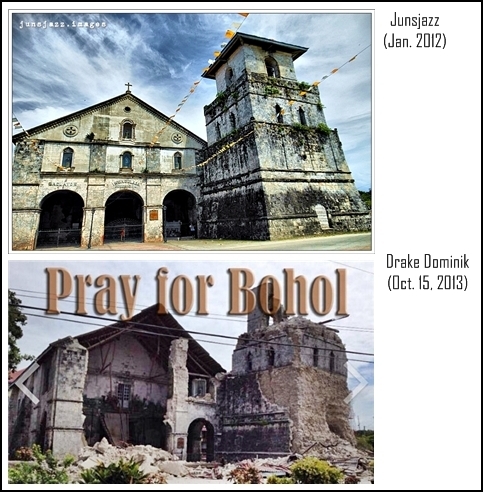 The Church of Our Lady of the Immaculate Conception in Baclayon town, Bohol. Built in 1717.
The Church of Our Lady of the Immaculate Conception in Baclayon town, Bohol. Built in 1717.
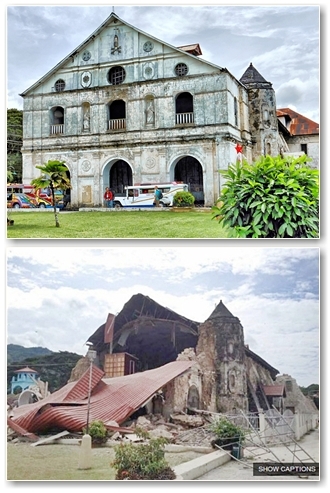 The Church of San Pedro in Loboc, Bohol, originally built in 1602.
The Church of San Pedro in Loboc, Bohol, originally built in 1602.
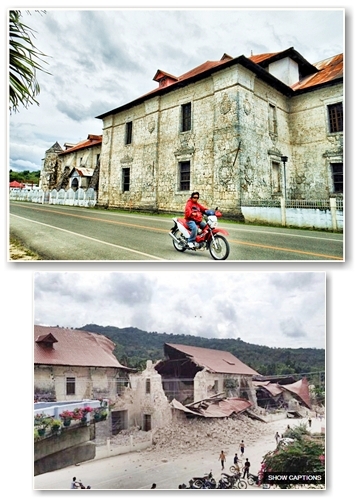
Another picture of the Loboc Church, from the side.
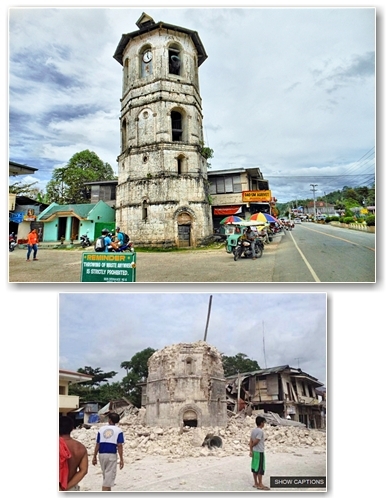 The original bell tower of Loboc Church stands some 100 meters away from the church structure. Now it’s just a stump on the ground.
The original bell tower of Loboc Church stands some 100 meters away from the church structure. Now it’s just a stump on the ground.
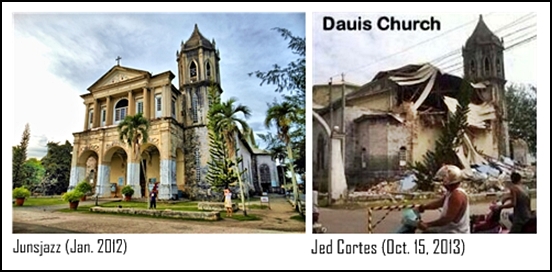 The Church of Our Lady of the Assumption in Dauis, Bohol built by Jesuits in mix style but influenced by Byzantine and Romanesque architecture.
The Church of Our Lady of the Assumption in Dauis, Bohol built by Jesuits in mix style but influenced by Byzantine and Romanesque architecture.
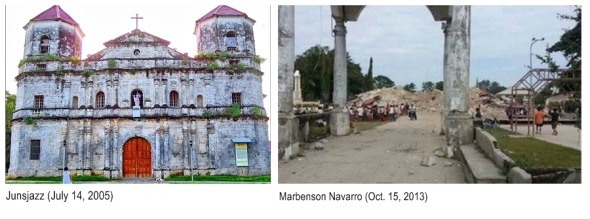 The Church of Our Lady of Light in Loon, Bohol was the biggest church in the province, built in 1753. The whole structure was pulverized to the ground.
The Church of Our Lady of Light in Loon, Bohol was the biggest church in the province, built in 1753. The whole structure was pulverized to the ground.
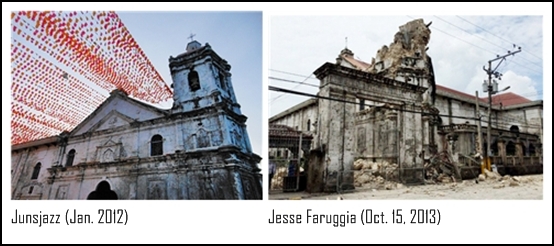 The Minor Basilica of the Holy Child in Cebu City, founded in 1565. It’s belfry fell off.
The Minor Basilica of the Holy Child in Cebu City, founded in 1565. It’s belfry fell off.
These old churches were built with materials during those times – coral stones, mud bricks, limestones – and are most fragile. Throughout their history, they have been subjected to fires, typhoons, previous earthquakes and even World War II. They were the first to come down during the powerful quake this week. Experts are assessing if some of them can be rebuilt, while others like the Loon Church which was flattened, may have a new church built on the site. I am quite fortunate to have captured the beauty and grandeur of these churches in their original condition before the disaster. Now I have them immortalized in images, and preserved in my memory as I saw them in their full glory.
Note: These churches are featured in Junsjazz Images & Inspiration Digital Magazine Issue #2.
Missed you all!
After nearly two months, I missed a lot – this blog and the great WP community of photo blogger peers – that’s all of you my friends! My apologies, I’ve been bogged down by online work. But my deepest thanks to all who commented, liked and visited during my absence. I’ll try my best to go around and visit your blogs during my free time. Keep on clicking everyone!

Drawn to symmetry
Article Excerpt:
Why is architectural symmetry so satisfying? As Leonardo da Vinci’s famous drawing demonstrated, it reflects the human body, which has a right side and a left, a back and a front, the navel in the very center. Du Sautoy writes that the human mind seems constantly drawn to anything that embodies some aspect of symmetry. He observes that “[a]rtwork, architecture and music from ancient times to the present day play on the idea of things which mirror each other in interesting ways.” When we walk around a Baroque church, we experience many changing views, but when we walk down the main aisle—the line along which the mirror images of the left and right sides meet—we know that we are in a special relationship to our surroundings. And when we stand below the dome of the crossing, at the confluence of four symmetries, we know we have arrived.
~Witold Rybczynski from his article Mirror Images: Why is symmetry so satisfying?
Church week
This excerpt was taken from my post last Oct. 14, 2012 titled Solemn Sanctuaries:
I always have this fascination for church structures, the older and bigger, the more interesting. They are such imposing landmarks with their towering belfries, ornate decors and massive interiors, fulfilling their roles as venerable venues for the faithful, and solemn sanctuaries for the Lord’s flock. The Philippines is a showcase of ancient churches, cathedrals and basilicas. As the only predominantly Catholic country in Asia, churches big and small, old and new abound all over the Philippines.
Yes folks, we revisit the churches, cathedrals and basilicas in my image collection, and how it is to capture the grandeur and details of these architectural landmarks. Welcome to another of JJ’s picture series. Have a splendid week ahead my friends!
Capturing the realism
The picture below was taken at Baluarte, a seaside park in the tourist island province of Bohol in central Philippines. When I reviewed the picture in my computer, it was far from what I saw on that day. My picture was bland and boring. It had to undergo post-processing to highlight the colors and details to more or less approximate the actual scene. How do we go about capturing the realism of a scene when we first saw it?
Kimball Larsen shares some pointers in his article 10 Photography Tips To Better Capture What You See. They are the following:
1. Decide on a clear center of attention
2. Remember that your eye has a better dynamic range than your camera
3. Aperture control for DOF
4. Careful composition to either expand upon or contract the feel of the photo
5. Be ready – moments come and go quickly
6. Understand the exposure triangle
7. P is not for “Professional”
8. Pay attention to your light sources
9. Always check your camera settings
10. Practice!
Again I suggest you go over the article and read Larsen’s descriptions on each tip. Giving thoughtful consideration to the above items will greatly improve our picture-taking. It helps elevate us to the level of a thinking photographer, deliberate and confident that our every shot will result in a faithful capture of what we saw. Happy shooting this weekend!
The bare bones
Article Excerpt:
The irony is that landscape photography is extremely difficult to do well. You’re relying not only on finding beautiful landscapes to photograph, but being there at the same time the weather and light are working together to create the conditions that you can use to photograph the landscape in a way that fulfills your creative vision. It takes a dedication that most of us don’t have.
When we’re in a landscape, we see it in colour. Black and white photography strips away the colour, leaving the bare bones. The features of the landscape, such as rocks, trees and mountains, become compositional elements made up of light, texture and tonal contrast. Black and white is beautiful. The photo becomes an interpretation, rather than a literal representation, of the landscape. We’re seeing the artist’s personal vision, and emotional response to the landscape, as well as the place itself.
~Andrew Gibson from his article How To Capture Stunning Fine Art Landscape Photographs
Photo Quotes 122
Being a photographer is making people look at what I want them to look at.~Ruth Orkin
The difference between framing and composition
 In a recent post we tackled the difference between “form” and “shape.” Oftentimes they are used similarly, but now we know they are two distinct concepts. This time we differentiate “framing” from “composition” which are also used comparatively. But one is not synonymous with the other. Framing is when you move your camera, pointing it up or down, or panning it from side to side to get that point of view or perspective. Or, you yourself go on the move – you bend, crouch, lie down, go on your side, go up on a vantage point, raise your camera above your head – all these physical efforts to get the best angle. Once you get that angle you are looking for, then you compose your shot. Composing is simply arranging the elements that you have framed. This requires thinking. You now draw knowledge from your cerebral vault all that you have read, the tips and techniques you’ve learned. If it’s a landscape shot, you know that to be effective you need a great background, a good middle ground and an eye-catching foreground as subject to serve as focal point. Composing is eliminating and simplifying. Take away the clutter and the unnecessary. Focus on the point of interest. For the trained photographer, composition will not require much thought. It becomes almost a reflex action, because he knows what to look out for in his composition – something interesting and engaging – the visual elements of colors, lines, shapes, forms, textures, patterns and light. Framing is the preliminary. Composing is where you put the elements together. Now, how effectively you placed these elements in relation to each other will either make or break the image. That’s how critical composition is. For further reading, I recommend this article How To Compose Photos Instead of Just Framing Them from PhotographyTalk. Have a great week ahead my blogger friends!
In a recent post we tackled the difference between “form” and “shape.” Oftentimes they are used similarly, but now we know they are two distinct concepts. This time we differentiate “framing” from “composition” which are also used comparatively. But one is not synonymous with the other. Framing is when you move your camera, pointing it up or down, or panning it from side to side to get that point of view or perspective. Or, you yourself go on the move – you bend, crouch, lie down, go on your side, go up on a vantage point, raise your camera above your head – all these physical efforts to get the best angle. Once you get that angle you are looking for, then you compose your shot. Composing is simply arranging the elements that you have framed. This requires thinking. You now draw knowledge from your cerebral vault all that you have read, the tips and techniques you’ve learned. If it’s a landscape shot, you know that to be effective you need a great background, a good middle ground and an eye-catching foreground as subject to serve as focal point. Composing is eliminating and simplifying. Take away the clutter and the unnecessary. Focus on the point of interest. For the trained photographer, composition will not require much thought. It becomes almost a reflex action, because he knows what to look out for in his composition – something interesting and engaging – the visual elements of colors, lines, shapes, forms, textures, patterns and light. Framing is the preliminary. Composing is where you put the elements together. Now, how effectively you placed these elements in relation to each other will either make or break the image. That’s how critical composition is. For further reading, I recommend this article How To Compose Photos Instead of Just Framing Them from PhotographyTalk. Have a great week ahead my blogger friends!
Maximize vantage point to get “the shot”
 “One of the most common mistakes an amateur/novice photographer makes is to take the majority of their photos standing up with the camera held near chest or eye level. Although this is the most comfortable/natural orientation it’s not the one that is going to yield impressive or unique photos. Everybody else is doing it and if you’re interested in taking photos that are going to impress an audience outside of friends and family it’s time to get down & dirty, climb, contort & twist your body all over the place.” I love this opening salvo of Samuel Jeffery from his article Change Your Vantage Point/Travel Photography Tips. We’ve touched on the topic of “point of view” from a previous post and this here is another one to emphasize its importance. I said in my previous post that people I’m with when out on vacation or travel don’t like my habit my wandering off and separating from them. I usually go to the “unbeaten path” and that’s the way of photographers. They search for other angles, for elevations, for vantage points. They will crouch, bend, go down low or stretch, tiptoe and peer above the crowd (if there’s any) or go up high and perch on something. The photographer will look at all possible positions to get that one shot that will not be the same from the throng of camera-toting, casual tourists. The above photo of the scenic Chocolate Hills, the main attraction in the tourist island province of Bohol in the Philippines, can only be taken with this vantage point – another hill. One of the roughly 1,200 similarly sized and shaped hills was converted into a viewing park and to reach the top you have to climb a stair or a pathway some 200 feet up. With an army of tourists with you at the top, all of you will have the same point of view. And all of them are snapping away. How do you get a different shot? No amount of body bending can make a distinct image. Here’s where patience came in handy. I eyed some dark clouds in the horizon and waited for them to move nearer. They did. The result is the shot above. The photographer will find ways. Ever since he held his first camera, it has always been a journey of finding ways to get “the shot.”
“One of the most common mistakes an amateur/novice photographer makes is to take the majority of their photos standing up with the camera held near chest or eye level. Although this is the most comfortable/natural orientation it’s not the one that is going to yield impressive or unique photos. Everybody else is doing it and if you’re interested in taking photos that are going to impress an audience outside of friends and family it’s time to get down & dirty, climb, contort & twist your body all over the place.” I love this opening salvo of Samuel Jeffery from his article Change Your Vantage Point/Travel Photography Tips. We’ve touched on the topic of “point of view” from a previous post and this here is another one to emphasize its importance. I said in my previous post that people I’m with when out on vacation or travel don’t like my habit my wandering off and separating from them. I usually go to the “unbeaten path” and that’s the way of photographers. They search for other angles, for elevations, for vantage points. They will crouch, bend, go down low or stretch, tiptoe and peer above the crowd (if there’s any) or go up high and perch on something. The photographer will look at all possible positions to get that one shot that will not be the same from the throng of camera-toting, casual tourists. The above photo of the scenic Chocolate Hills, the main attraction in the tourist island province of Bohol in the Philippines, can only be taken with this vantage point – another hill. One of the roughly 1,200 similarly sized and shaped hills was converted into a viewing park and to reach the top you have to climb a stair or a pathway some 200 feet up. With an army of tourists with you at the top, all of you will have the same point of view. And all of them are snapping away. How do you get a different shot? No amount of body bending can make a distinct image. Here’s where patience came in handy. I eyed some dark clouds in the horizon and waited for them to move nearer. They did. The result is the shot above. The photographer will find ways. Ever since he held his first camera, it has always been a journey of finding ways to get “the shot.”
Photo Quotes 87
The truly creative photographer learns to quickly shift gears to take advantage of unexpected but wonderful things that come up along the way.~Harold Davis
Seeing shadows and shades
 Most of us avoid shadows and shades. Without the proper camera setting, or in-cam picture modes like backlighting and HDR effects, those shadows and shades become just dark, undefined areas in an image. We would not want that. Shadows and shades are caused by a light source. Inside our houses those are caused by flourescent lights, bulbs and lamps. Outside there is one primary light source and that is the sun. Where the sun is at the time of day determines where shadows set, as the sun’s light falls on objects. Midday sun is harsh and bright and will cast deep shadows right under objects. Photographers prefer the sun on the horizon, during sunrise or sunset, where light is soft and subdued, where dramatic colors come out, and where shadows from objects cast long, striking forms. Wherever shadows fall at whatever time of day, the keen photographer will be aware of the light and the shadows, and will use them to effectively compose his image. This article by Jmeyer titled Creative Landscape Photography: Master the Dark Art of Shadows and Shade will guide us on how to properly manage and compose our shot utilizing to our advantage those shadow elements. He shares tips on where to place the sun, how to get the right exposure, how to be creative with shadows and how to shoot with a low sun and shadow. Though the article is generally a guide on landscape photography, the techniques provided by the author can be applied on other genres and shooting situations because essentially it is all about the placement of light and how it affects subjects. Shadows and shades are created by the light source. Knowing how to capably capture them and expertly place them in the frame as they form shapes, patterns, lines and textures can result in visually compelling images. (Photo location: Loboc River, Bohol province)
Most of us avoid shadows and shades. Without the proper camera setting, or in-cam picture modes like backlighting and HDR effects, those shadows and shades become just dark, undefined areas in an image. We would not want that. Shadows and shades are caused by a light source. Inside our houses those are caused by flourescent lights, bulbs and lamps. Outside there is one primary light source and that is the sun. Where the sun is at the time of day determines where shadows set, as the sun’s light falls on objects. Midday sun is harsh and bright and will cast deep shadows right under objects. Photographers prefer the sun on the horizon, during sunrise or sunset, where light is soft and subdued, where dramatic colors come out, and where shadows from objects cast long, striking forms. Wherever shadows fall at whatever time of day, the keen photographer will be aware of the light and the shadows, and will use them to effectively compose his image. This article by Jmeyer titled Creative Landscape Photography: Master the Dark Art of Shadows and Shade will guide us on how to properly manage and compose our shot utilizing to our advantage those shadow elements. He shares tips on where to place the sun, how to get the right exposure, how to be creative with shadows and how to shoot with a low sun and shadow. Though the article is generally a guide on landscape photography, the techniques provided by the author can be applied on other genres and shooting situations because essentially it is all about the placement of light and how it affects subjects. Shadows and shades are created by the light source. Knowing how to capably capture them and expertly place them in the frame as they form shapes, patterns, lines and textures can result in visually compelling images. (Photo location: Loboc River, Bohol province)
Photo Quotes 77
Life is like a landscape. You live in the midst of it but can describe it only from the vantage point of distance.~Charles Lindbergh (Photo location: Chocolate Hills, Bohol province)
Photo Quotes 59

See the subject first. Do not try to force it to be a picture of this, that or the other thing. Stand apart from it. Then something will happen. The subject will reveal itself.~Bill Brandt (Photo location: Baclayon Church, Bohol province)
Symbols of faith
 I have around five previous posts regarding pictures of churches and how to photograph them. I can’t get enough of them so here’s another one which is probably not the last since I have a whole collection of them. My country the Philippines has a population of 95 million and 90 percent of them are Catholics. It is the only predominantly Catholic country in Asia, brought about by 300 years of Spanish colonial rule which started in the 1500s. The influence of religion is thus ingrained and pervasive in the peoples’ psych and culture, and most evident in the places of worship. From the far-flung towns to the urban centers, church structures abound, from the modern to the centuries old. They stand as symbols of faith, much like the Muslim mosques and the Buddhist temples. To individuals like me, churches, basilicas and cathedrals are profound photographic subjects. They have this visual grandeur and alluring solemnity. They invoke an aura of mysticism, serenity and of course spirituality. Those are intangibles that are represented in what we can see – the shapes, form, patterns, details, lines – elements which are in the microcosm of the physical church structure whether in its cavernous interior or its towering exterior. When you get the chance to tour my country, make it a point to visit the churches. First give thanks to the Almighty for all the blessings he has given you in this life, then pray that all the pictures you’ll take afterwards will be sharp, vivid, clear and in focus. Amen. (Photo location: Dauis Church, Panglao Island)
I have around five previous posts regarding pictures of churches and how to photograph them. I can’t get enough of them so here’s another one which is probably not the last since I have a whole collection of them. My country the Philippines has a population of 95 million and 90 percent of them are Catholics. It is the only predominantly Catholic country in Asia, brought about by 300 years of Spanish colonial rule which started in the 1500s. The influence of religion is thus ingrained and pervasive in the peoples’ psych and culture, and most evident in the places of worship. From the far-flung towns to the urban centers, church structures abound, from the modern to the centuries old. They stand as symbols of faith, much like the Muslim mosques and the Buddhist temples. To individuals like me, churches, basilicas and cathedrals are profound photographic subjects. They have this visual grandeur and alluring solemnity. They invoke an aura of mysticism, serenity and of course spirituality. Those are intangibles that are represented in what we can see – the shapes, form, patterns, details, lines – elements which are in the microcosm of the physical church structure whether in its cavernous interior or its towering exterior. When you get the chance to tour my country, make it a point to visit the churches. First give thanks to the Almighty for all the blessings he has given you in this life, then pray that all the pictures you’ll take afterwards will be sharp, vivid, clear and in focus. Amen. (Photo location: Dauis Church, Panglao Island)
Photographers are communicators of light
Book Excerpt: “Light is the most positive energy we know. It reveals truth. Most of the energy that light emits strikes a surface, bounces off , and then goes elsewhere. Light is so essential that we cannot exist without it. Our lives depend on light as much as they do upon water. Through photography, we capture for ourselves and share with others the glory of that positive, critical energy. Just like life, light brings us great joy. Light comes in many colors. As photographers, we are communicators of light. The images that we create enter the body through the eyes and travel to the brain, evoking a response. Love the light, the energy, the joy, the color: communicate positively for the rest of your life. Celebrate and share every visual exploration.”~Brian & Janet Stoppee, Guide to Photography and Light
Photo Quotes 48
A photographer must be prepared to catch and hold on to those elements which give distinction to the subject or lend it atmosphere…Sometimes they are a matter of luck…Sometimes they are a matter of patience…~Bill Brandt (Photo location: Loboc Church, Bohol)
The angle of attack
 How do you “attack” a subject? Sneak up below from the trenches, dive on from above kamikaze style, or do the frontal assault with your weapon in full automatic burst mode. Arrgh! I miss playing Call of Duty. But rather than shooting enemies in video war games, I’d rather go out and shoot subjects who don’t shoot back. Whatever angle you choose to take pictures of your subject, whether from below, from above or at eye level, keep in mind the fundamentals – the rule of thirds, lighting, framing, subject placements, colors, contrasts, shadows, midtones (we’ve tackled many of them in previous posts) – or never mind them at all. Go with your gut feel, follow your instincts, adhere to your concept, present it your way, keep it interesting, find something others can relate and understand. It is your story. Now back to shooting angles. Here’s another generous list of tips: Try Using Different Angles To Improve Your Photos. Variety and a new way of looking at subjects invite attention and interest. Notice how aerial shots get our attention because it is seldom that we are in the air shooting at landscapes and objects below. A different perspective and adjustments in shooting angles can vastly enhance the compositional element of an image. (Photo location: Sagbayan Park, Bohol)
How do you “attack” a subject? Sneak up below from the trenches, dive on from above kamikaze style, or do the frontal assault with your weapon in full automatic burst mode. Arrgh! I miss playing Call of Duty. But rather than shooting enemies in video war games, I’d rather go out and shoot subjects who don’t shoot back. Whatever angle you choose to take pictures of your subject, whether from below, from above or at eye level, keep in mind the fundamentals – the rule of thirds, lighting, framing, subject placements, colors, contrasts, shadows, midtones (we’ve tackled many of them in previous posts) – or never mind them at all. Go with your gut feel, follow your instincts, adhere to your concept, present it your way, keep it interesting, find something others can relate and understand. It is your story. Now back to shooting angles. Here’s another generous list of tips: Try Using Different Angles To Improve Your Photos. Variety and a new way of looking at subjects invite attention and interest. Notice how aerial shots get our attention because it is seldom that we are in the air shooting at landscapes and objects below. A different perspective and adjustments in shooting angles can vastly enhance the compositional element of an image. (Photo location: Sagbayan Park, Bohol)
Limited by a point & shoot cam
 Oh don’t be! As I said before its not the camera but who is behind the camera. A camera is just a tool, what goes into it is largely dependent on the one who clicks the shutter. Admittedly, the lowly P&S cams have less features and options compared to expensive DSLRs. But that doesn’t mean you can’t take great pictures. Understanding the limitations and maximizing what your P&S cam can do plus your knowledge of composition and other essentials (been tackling them in my earlier posts) will go a long way in ensuring you take great photos. Self-taught photographer Max Edin itemizes the shortcomings of P&S cams and how to overcome them in his enlightening article How to Take Better Pictures with Your Point-and-Shoot Camera. You may graduate to a DSLR in the future, but if what you have now is a P&S cam then take heart, it can capture images better than you think. You just need to know how to do it. By the way, I took the above photo with a 5-megapixel Canon S2-IS, a point-and-shoot camera. (Photo location: Waterfalls at Loboc River, Bohol province)
Oh don’t be! As I said before its not the camera but who is behind the camera. A camera is just a tool, what goes into it is largely dependent on the one who clicks the shutter. Admittedly, the lowly P&S cams have less features and options compared to expensive DSLRs. But that doesn’t mean you can’t take great pictures. Understanding the limitations and maximizing what your P&S cam can do plus your knowledge of composition and other essentials (been tackling them in my earlier posts) will go a long way in ensuring you take great photos. Self-taught photographer Max Edin itemizes the shortcomings of P&S cams and how to overcome them in his enlightening article How to Take Better Pictures with Your Point-and-Shoot Camera. You may graduate to a DSLR in the future, but if what you have now is a P&S cam then take heart, it can capture images better than you think. You just need to know how to do it. By the way, I took the above photo with a 5-megapixel Canon S2-IS, a point-and-shoot camera. (Photo location: Waterfalls at Loboc River, Bohol province)
Photo Quotes 17
Seeing is not enough; you have to feel what you photograph.~Andre Kertesz (Photo location: Man-made forest, Bilar town, Bohol province)
Photo Quotes 7
I love taking pictures because it’s instant art.~Dave Davidson (Photo location: Loay town, Bohol province)
Tourist island province
 More than 1,200 cone-shaped hills scattered over eight towns in the island province of Bohol in central Philippines. This geological wonder, famously known as the Chocolate Hills (the vegetation turns brown during summer hence the name), is the main attraction of the tourist island province which is just a couple of hours by passenger fast craft from metropolitan Cebu City. Bohol is a combination of provincial charm and cultural heritage, and blessed with abundant natural resources. It boasts of caves, waterfalls, pristine beaches, green rivers, one of the best sunsets, friendly people, historic landmarks, great dive sites, one of the longest zip lines in the country, and a century-old church in almost every town. All of these can be toured in just one day. If ever you’re planning a vacation in the Philippines, do include the premier tourist island province of Bohol in your itinerary. You won’t regret it. Here is the official website of this “little paradise.”
More than 1,200 cone-shaped hills scattered over eight towns in the island province of Bohol in central Philippines. This geological wonder, famously known as the Chocolate Hills (the vegetation turns brown during summer hence the name), is the main attraction of the tourist island province which is just a couple of hours by passenger fast craft from metropolitan Cebu City. Bohol is a combination of provincial charm and cultural heritage, and blessed with abundant natural resources. It boasts of caves, waterfalls, pristine beaches, green rivers, one of the best sunsets, friendly people, historic landmarks, great dive sites, one of the longest zip lines in the country, and a century-old church in almost every town. All of these can be toured in just one day. If ever you’re planning a vacation in the Philippines, do include the premier tourist island province of Bohol in your itinerary. You won’t regret it. Here is the official website of this “little paradise.”
Photoshop online
Above is a dull photo. It is underexposed, has a colorless sky and a dark foreground. I’m not a Photoshop user because I find the editing software expensive, not that user friendly and requires a steep learning curve. Besides, I’m not much into photo manipulation, I’m more into tweaks and image enhancements. But when I came to know of Photoshop Express Editor, the free online version of Adobe’s popular software, I just had to try it. Using the saturation option I was able to put a pinkish-red tint in the sky, brighten up the image, and with the dodge and burn tool was able to highlight the dark rocks on the foreground. Great for basic photo improvements. Try it, sign-up is not even required. Now see the difference with the improved image below.

(Photo location: Loay, Bohol)

































